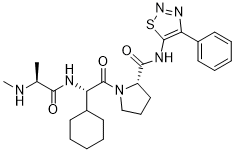| Description: |
GDC-0152 is a potent inhibitor of IAPs which binds to the XIAP BIR3 domain, the BIR domain of ML-IAP, and the BIR3 domains of cIAP1 and cIAP2 with Ki values of 28, 14, 17, and 43 nM, respectively. |
| In Vitro: |
GDC-0152 can block protein−protein interactions that involve IAP proteins and pro-apoptotic molecules. Using transiently transfected HEK293T cells, GDC-0152 is shown to disrupt XIAP binding to partially processed caspase-9 and to disrupt the association of ML-IAP, cIAP1, and cIAP2 with Smac. In melanoma SK-MEL28 cells, the endogenous association of ML-IAP and Smac is also effectively abolished by GDC-0152. GDC-0152 leads to a decrease in cell viability in the MDA-MB-231 breast cancer cell line, while having no effect on normal human mammary epithelial cells (HMEC). GDC-0152 is found to activate caspases 3 and 7 in a dose- and time-dependent manner. GDC-0152 is shown to induce rapid degradation of cIAP1 in A2058 melanoma cells. It effectively induces degradation of cIAP1 at concentrations as low as 10 nM, consistent with its affinity for cIAP1[1]. |
| Kinase Assay: |
Inhibition constants (Ki) for the antagonists are determined by addition of the IAP protein constructs to wells containing serial dilutions of the antagonists or the peptide AVPW, and the Hid-FAM probe or AVP-diPhe-FAM probe, as appropriate, in the polarization buffer. Samples are read after a 30-minute incubation. Fluorescence polarization values are plotted as a function of the antagonist concentration, and the IC50 values are obtained by fitting the data to a 4-parameter equation using software. Ki values for the antagonists are determined from the IC50 valued. |
| Cell Assay: |
Detached cells are washed with phosphate-buffered saline (PBS) and are resuspended in assay media (MDA-MB-231 cells: RPMI1640 supplemented with 10% fetal bovine serum and 2 mM L-glutamine [GlutaMAX-1]) or culture media (HMECs: MEBM® with MEGM SingleQuots®). Cells are placed in tissue culture-treated, white-wall or black-wall, clear-bottom, 96-well plates at 1×104 cells/well in a volume of 50 μL. The plates are incubated at 37°C and 5% CO2 overnight, the media is removed, and GDC-0152 or it's enantiomer are added in assay media. Cells cultured in white-wall, clear-bottom plates are incubated at 37°C and 5% CO2 for 3 days before cell viability is measured using the CellTiter-Glo® luminescent cell viability assay kit. |
| Animal Administration: |
Cells are resuspended in PBS and the cell suspension is mixed 1:1 with Matrigel. The cells (1.5×107) are then implanted subcutaneously into the right flank of 130 female nude mice aged 6-8 weeks. Tumor volumes are calculated. Ten mice with the appropriate mean tumor volume are assigned randomLy to each of six groups. The mean tumor volume±the standard error of the mean (SEM) for all six groups is 168±3 mm3 at the initiation of treatment (Day 0). Mice are dosed 1 or vehicle (PBS) by oral gavage with a dose volume of 4.0 mL/kg. The mice are observed on each day of the study, and tumor volumes and body weights are measured twice each week. Percent tumor growth inhibition is calculated using the formula %TGI=100× (1- Tumor Volumedose/Tumor Volumevehicle). |
| References: |
[1]. Flygare JA, et al. Discovery of a potent small-molecule antagonist of inhibitor of apoptosis (IAP) proteins and clinical candidate for the treatment of cancer (GDC-0152). J Med Chem. 2012 May 10;55(9):4101-13. |






















